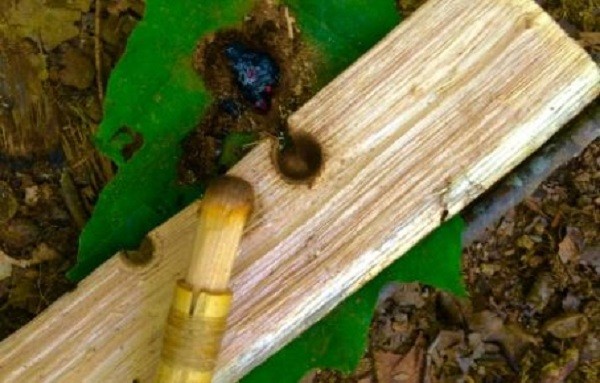Stuck in the wilderness without matches or a lighter is somewhere nobody wants to be. Hopefully, you will never be in this situation, but if you keep the tricks below in mind, you should still have no problem getting a fire going.
Material and Tools
Cordage – about two feet of sturdy cordage
Spindle – my river cane spindle capable of using wooden plugs or any spindle material you have available
Hearth Board – a suitable wood for friction fire 1 to 2 inches wide, 1/2 inches deep, and long enough to place your foot on it with enough board left for drilling
Knife – whittling plugs, divots, and hearths
Welcome Mat – a leaf, piece of leather, or anything which will collect the charred dust and glowing ember
Step 1: Notch Your Spindle
Cut a 1/8 inch nock in the top of the spindle deep enough for your cordage to mate securely.
Step 2: Cut Cordage to Length
You need a length of cord which will drape through the nock and hang down the spindle. Allow enough excess for tying a loop on each end of the hanging cordage. Adjust the length until your thumbs (inserted in the loops) and hands are in the middle of the spindle when assembled.
Step 3: Tie Two Loops
The height of your hands should be near the middle of the spindle for balance
Trim the loose ends of the loops near the knots. I found that leftover cordage can get in the way while spinning the spindle.
Step 4: Give ‘em a Spin
Place your thumbs through the loops and grip the spindle between your palms. Place the bottom of the spindle in a divot hole in the hearth board. Begin slowly twirling the spindle between your hands to get the feel of how the thumb loops aid in spinning. As you spin you should notice the divot should begin to smoke and create a bit of charred dust around the rim of the divot. Stop and prepare the divot with a V-shaped notch which slices into the pie-shaped divot hole.
Step 5: Go for the Coal
The loops will generate a lot of downward pressure on the hearth board. Don’t overdo it in this beginning stage or you may drill through your hearth board without producing a coal. Spin with medium pressure until the hearth board notch is filled with charred dust.
Now is the time to apply more downward pressure and rapid spinning. If you think you’re to that point with smoke flying, stop spinning but keep the spindle mated to the board socket. Watch to see if the char is producing smoke on its own. If so, gently remove the spindle and tap the hearth board to loosen the char from the notch.
Congratulations! You’ve produced a primal ember by rubbing two sticks together. Now transfer the fire-egg to a tinder nest and blow it to flame.
With the use of thumb loops, making a friction fire using only your hands is going to be a much easier, and generally more successful, task. They will keep your hands from sliding down the spindle as you spin it, which will not only make this a quicker task (you won't have to keep readjusting your hands) but it will also mean fewer blisters.
What makes this lesson especially helpful, though, is the advice on how much pressure to place on the hearth board. If you use too much too soon you won't get the hot dust necessary for generating a fire.
Hopefully, you found these tips useful. If you would like to learn more, head over to Survival Sherpa.
Featured Image via Survival Sherpa

What are the best woods for making a friction fire
Helpful ! I’ve been trying this method and I get char dust but no coal. Think my notch is too big and I’m not being patient enough to turn char dust into coal.
I heard hard wood is best but I had a really good one going with red cedar on red cedar. Gave me a lot of chances before it drilled through the hearth board
Thanks for the info